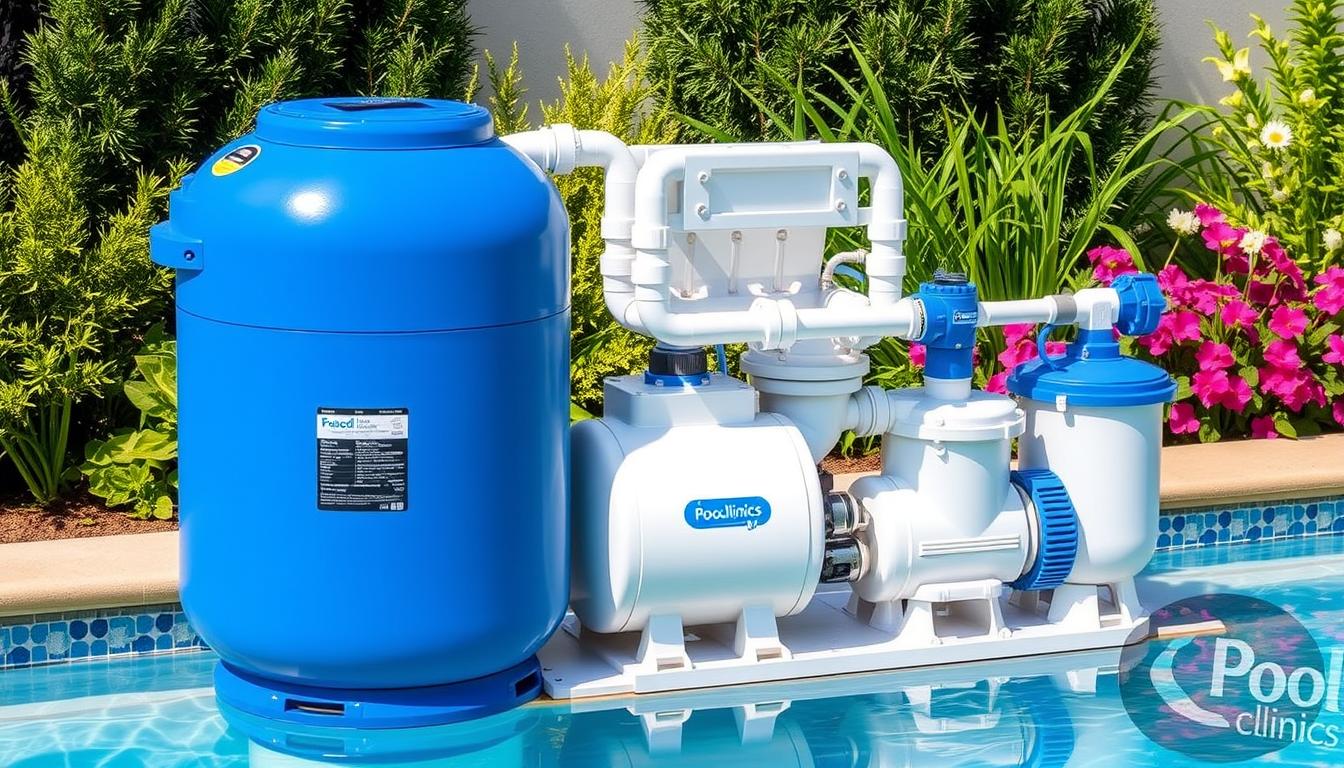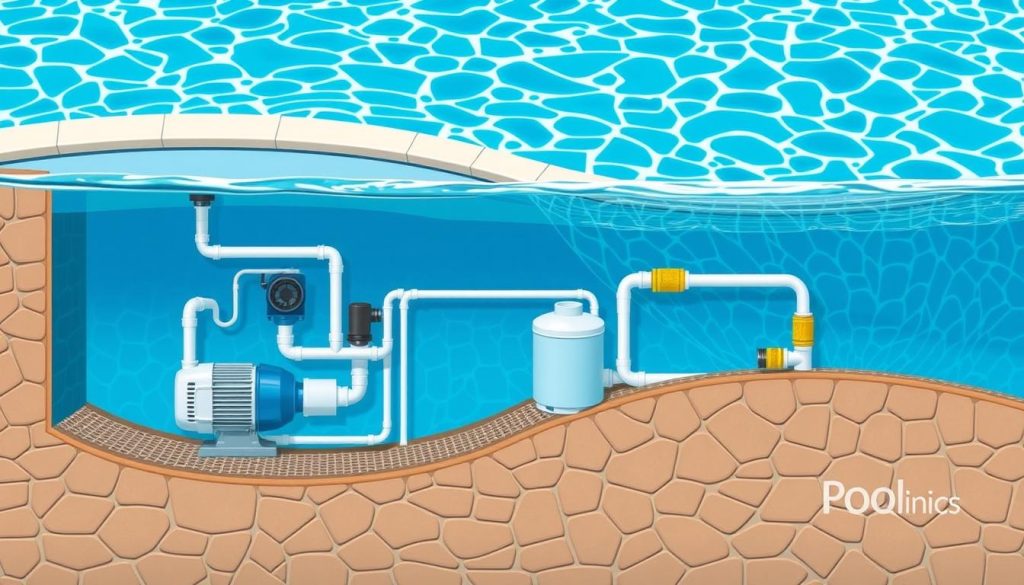
Clean, safe pools are essential for family fun. The pool industry has spent decades perfecting equipment for smooth pool operations. Pump and filter systems are vital for keeping pool water pristine.
This guide explores inground pool pump and filter systems in depth. We’ll cover single-speed, dual-speed, and variable-speed pumps from top brands. We’ll also discuss sand, cartridge, and D.E. filters and how they work with pumps.
Knowing your pool’s circulation system is key for maintenance. We’ll explain how water flows through skimmers, drains, pump, filter, heater, and salt chlorinator. This knowledge helps you spot and fix issues quickly.
Good maintenance prevents common filtration problems. We’ll share tips on priming pumps and maintaining filters. Regular checks of water levels and timely filter media replacements are crucial.
Backwashing and deep cleaning keep your system running smoothly. These steps ensure your pump and filter perform at their best.
Key Takeaways:
- Inground swimming pool pump and filter systems are essential for maintaining clean, safe, and enjoyable pool water.
- The three main types of pool pumps are single-speed, dual-speed, and variable-speed pumps, each offering unique benefits in terms of energy efficiency, performance, and cost-effectiveness.
- Pool filters, such as sand, cartridge, and D.E., work in conjunction with the pump to remove dirt, debris, and bacteria from the water.
- Understanding your pool’s circulation system and plumbing is crucial for proper maintenance and troubleshooting.
- Regular maintenance, including monitoring water levels, backwashing, deep cleaning, and replacing filter media, is essential for optimal performance and avoiding common filtration system issues.
Understanding Your Pool’s Circulation System
A functioning circulation system keeps your pool clean and healthy. It uses plumbing parts to filter water and return it clear. Good circulation spreads sanitizers evenly, stopping bacteria growth and ensuring safe swimming.

How Pool Water Flows Through the System
Pool water starts its journey at the skimmers and main drains. Skimmers sit on pool walls below water level, catching floating debris. Main drains at the pool bottom help pull water from the floor.
Suction lines guide water from skimmers and drains to the pump. The pump, the system’s heart, moves water through pipes. It comes in various sizes to match pool volume.
After the pump, water goes to the filter for cleaning. The filter removes dirt and tiny particles. Three main filter types exist: sand, cartridge, and diatomaceous earth (D.E.).
Clean water returns to the pool through adjustable jets. These jets spread water evenly, preventing still areas where algae grow. You can control the direction and flow of returning water.
The Role of Skimmers and Main Drains
Skimmers and main drains pull water into the plumbing. Skimmers catch floating debris like leaves and toys. For best results, keep water level halfway up the skimmer opening.
Main drains sit at the pool bottom, drawing water from the floor. They ensure full water circulation, stopping stagnant areas. Main drains are less common in home pools but crucial for larger ones.
| Component | Function |
|---|---|
| Skimmers | Capture floating debris and draw water into the plumbing system |
| Main Drains | Draw water from the pool floor to ensure complete circulation |
| Suction Lines | Guide water from skimmers and main drains to the pump |
| Pump | Powers the flow of water through the plumbing system |
| Filter | Removes debris, dirt, and microscopic particles from the water |
| Return Jets | Distribute clean water evenly throughout the pool |
Knowing each part’s role helps you maintain your pool better. This ensures a clean, healthy space for family fun. Regular upkeep keeps your pool enjoyable all season long.
Essential Components of Your Pool’s Pump and Filter System
Your inground pool needs a good pump and filter system. These parts work together to keep the water clean and safe. Let’s look at the key pieces of this system.
The Pool Pump: The Heart of the System
The pool pump moves water through the system. It pulls water from the pool through suction lines. This ensures good water flow and stops clogs.
The pump has a big strainer pot in front. It catches large debris before it enters the system. After the strainer pot, the impeller pushes water to the filter.
Types of Pool Filters: Sand, Cartridge, and D.E.
There are three main types of pool filters. These are sand filters, cartridge filters, and diatomaceous earth (D.E.) filters. Each type cleans water differently.
| Filter Type | Filtration Method | Maintenance |
|---|---|---|
| Sand Filters | Water is pushed through sand, trapping particles and allowing clean water to pass through | Backwashing required to clean the sand |
| Cartridge Filters | Effective in removing smaller particles from the water | Easy maintenance by rinsing or replacing the cartridge |
| D.E. Filters | Offers the highest level of filtration, able to filter out impurities down to microscopic levels | Requires periodic backwashing and replenishment of D.E. powder |
Filter quality is measured by micron level. A lower micron level means better filtration. Filters catch debris measured in microns. Bacteria are about 2 microns in size.
The Pool Heater: Options for Keeping Your Water Warm
Pool heaters extend your swimming season. They keep the water at a nice temperature. The main types are electric heat pumps, solar heaters, and gas heaters.
Most pool owners choose electric heat pumps. They’re reliable and cheap to run. About 95% of new heater installs are heat pumps.
Heat pumps take heat from the air. They put it into the pool water over time. Gas heaters heat water fast. They’re good for pools not used daily.
Salt Chlorine Generators: An Alternative to Traditional Chlorine
Salt chlorine generators offer a different way to clean pools. You add salt to the water instead of chlorine. The generator turns the salt into chlorine.
These generators work with the pump and filter. Together, they keep the water clean and safe for swimming.
Inground Swimming Pool Pump and Filter System Maintenance
Keeping your pool’s pump and filter system in top shape is crucial. Regular upkeep ensures clear water and smooth operation. Let’s explore key maintenance tasks for your pool equipment.
Priming Your Pool Pump for Optimal Performance
Priming your pool pump is vital for its proper function. It involves filling the pump with water before starting it. This step prevents damage and creates necessary suction.
To prime your pump, follow these steps. First, turn off the pump and open the basket lid. Then, fill the basket with water to the inlet port.
Next, replace the lid securely and turn on the pump. Finally, watch the pump for a few minutes to check for smooth operation.
- Turn off the pump and open the lid of the pump basket.
- Fill the basket with water until it reaches the top of the inlet port.
- Replace the lid securely and turn on the pump.
- Monitor the pump for a few minutes to ensure it is running smoothly and there are no air leaks.
Maintaining Your Pool Filter for Clear, Clean Water
Your pool filter is key to keeping water clean and clear. Maintenance needs vary based on filter type: sand, cartridge, or DE. All filters need regular cleaning to prevent clogs.
Here are some general pool filter maintenance tips:
- Check the pressure gauge regularly and clean the filter when the pressure rises 8-10 psi above the normal operating level.
- For sand filters, backwash and rinse the filter according to the manufacturer’s instructions.
- For cartridge filters, remove and clean the cartridges with a hose or replace them if they are worn out.
- For DE filters, backwash the filter and add fresh DE powder as needed.
Troubleshooting Common Pump and Filter Issues
Despite regular maintenance, you may face issues with your pool pump or filter. Common problems include priming issues, low water flow, and motor problems.
| Problem | Possible Causes | Solutions |
|---|---|---|
| Pump not priming | Air leaks, low water level, clogged baskets | Check for leaks, add water to the pool, clean baskets |
| Low water flow | Clogged filter, skimmer, or pump basket; air leaks | Clean filter and baskets, check for and fix air leaks |
| Pump motor not running | Power supply issues, motor problems | Check circuit breaker, fuses, and connections; replace motor if necessary |
| Leaks around pump | Damaged seals, O-rings, or pump housing | Inspect and replace worn or damaged parts |
Remember, if you’re unsure about how to resolve a problem or feel uncomfortable handling pool equipment, don’t hesitate to contact a professional pool service technician for assistance.
Regular pool pump and filter maintenance ensures a clean, healthy pool. Prompt troubleshooting and proper winterizing keep your equipment in great shape. Enjoy your inviting pool all season long!
Conclusion
Understanding your pool’s pump and filter system is crucial for a clean, safe swimming environment. Familiarizing yourself with the circulation system and components ensures top condition throughout the season. Proper maintenance techniques are key to keeping your pool in excellent shape.
Choosing the right filter type is essential for optimal pool performance. Cartridge filters capture smaller particles, providing high-quality filtration. Sand filters are less effective for fine particles. D.E. filters offer the finest filtration, trapping even the tiniest particles.
When selecting a pool heater, consider eco-friendliness, efficiency, and operational costs. These factors will help you make the best choice for your specific needs. Your decision will impact both your pool’s performance and your wallet.
Regular maintenance is vital for a smooth-running pump and filter system. This includes priming the pool pump and cleaning or replacing filter media. Addressing problems promptly extends equipment life and ensures a crystal-clear pool all season.
With this guide, you’re well-equipped to manage your inground pool’s pump and filter system. Your newfound knowledge will help create a safe and enjoyable swimming experience for everyone. Take charge of your pool maintenance and reap the rewards of a sparkling, inviting oasis.







